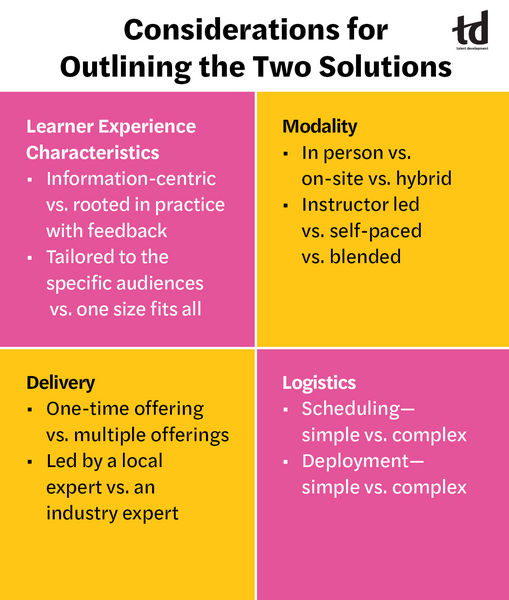TD Magazine Article
This or That?
Use a two-solution pitch to present an alternate learning solution for the one someone requests.
Fri Dec 30 2022

Do you field requests for training or courses unlikely to achieve meaningful results? Is there limited opportunity to revise the solution to make it have more of an impact?
Helping stakeholders buy into an alternative to their solution can be an uphill battle, particularly when the working relationship is in the early stages, a power imbalance exists, or communication with stakeholders or the client is indirect.
When another solution exists that is likely to deliver the desired results, consider crafting and delivering a two-solution pitch, a technique for initiating productive dialogue about what is possible with corporate learning.
In the workplace, stakeholders ultimately care about performance. As talent development professionals, we care about performance too—but it is common for that shared goal to get lost or go unmentioned in discussions of learning. TD contributes value to the business organization—the better people perform on the job, the better positioned the organization is to meet its goals and fulfill its mission. Communicating the value of effective workplace learning in terms of benefits to the business organization demonstrates your position as a partner when it comes to performance.
To that end, the two-solution pitch technique is one way to clearly communicate the shared performance goal while highlighting how an alternative learning solution better positions the organization to meet that goal versus the requested solution.
The next time you encounter a request for a specific solution and recognize the potential for an alternative approach worth pursuing, follow these six basic steps to craft a two-solution pitch.
Step 1: Acknowledge and document the initial request
Your goal in this first step is to signal your willingness to partner on developing a solution that will achieve results. Acknowledgment can be as simple as: "I received your request. Let's find a time to discuss further." At this early stage, stop short of committing to produce the requested solution.
Step 2: Conduct an analysis
Move forward with an analysis to determine what learners need to do as a result of training, identify the true business problem, and establish stakeholder priorities.
Stakeholders often prioritize business outcomes, such as boosting sales, reducing costs, increasing profits, or serving customers. At a glance, it may seem as though TD embraces different priorities, often focusing on upskilling employees, onboarding new talent, or other professional development initiatives. However, remember that everyone is working collectively toward the shared performance goal.
If someone requests a full-day sales training class, for example, dig further and determine how the request relates to helping people perform better on the job and improving business outcomes. Time and effort invested at this stage pay off later because identifying a problem is more challenging than formulating a list of potential solutions— and you want to select an alternative solution aimed at the specific business problem, not just any problem.
Step 3: Outline the pros and cons of the requested solution
If you find it challenging to identify beneficial aspects, temporarily adopt the stakeholder's point of view because the potential benefits could be related to logistics, efficiency, turnaround time, or risk. For example, a stakeholder may request a single course deployed to all employees because implementation via a learning management system is relatively simple, which could signal that the stakeholder views ease of deployment as beneficial.
When identifying the requested solution's downsides, be sure at least one is a clear downside from the stakeholder's point of view. Building on the above example, if turnaround time is important to the business but translation and localization are necessary before deploying the course to a global audience, then a turnaround time of months rather than weeks could be a major downside from the stakeholder's standpoint.
Vague learning outcomes or a poor learning experience may get a learning professional's attention, but will it give pause to a business leader? Keeping stakeholders' priorities and the true business problem at the forefront is likely to be helpful here. Establishing those details sets the stage for identifying a viable alternative in the next step.
Step 4: Formulate a contrasting solution
The solution should be more likely to produce the desired results, address the true business problem, or align with stakeholder priorities. Document the alternative solution, taking care to clearly outline its potential benefits and how it helps to address or minimize one or more downsides associated with the requested solution. You want to recommend a single alternative because:
Creating contrast with the original request is crucial for productive dialogue and alignment—the two- solution pitch is simply a vehicle to help stakeholders see what else is possible prior to fully committing resources for developing a solution.
Design involves trade-offs—stakeholders make decisions in the face of limited resources.
Pitching two solutions, side by side, is one way to clearly outline the potential upsides and downsides of each option.
Presenting multiple options may lead to choice overload; if overwhelmed, the decision maker could put off or avoid a decision altogether and retreat to what is familiar, likely the solution that they initially requested.
Step 5: Craft your pitch
Start with a summary of what the solution aims to achieve. Be sure the summary maintains a business perspective, because this is an opportunity to demonstrate your position as a partner to the business by communicating a clear understanding of the organization's priorities and needs. The information and insights you gathered during step 2 will be particularly helpful here.
Outline the two options, taking care to frame the alternative as an attractive option with clear benefits tying back to what the solution aims to achieve. For example, if the business wants to increase sales, and analysis reveals an opportunity with delivering value propositions to potential customers, highlight how and why the contrasting solution will strengthen the sales team's value proposition delivery, thus boosting the conversion rate and subsequently improving sales volumes.
You can frame the contrasting solution in a beneficial light in one of a multitude of ways, but tailor the details to your specific context. The figure below offers some broad suggestions for what to consider when outlining the two options; however, the list is not exhaustive, nor should you view it as a set of required details. Be thoughtful about which details to highlight based on the audience and what is important to the stakeholder. After all, what resonates positively with one person or organization will not necessarily resonate in the same way with another.
When crafting messaging, resist the temptation to concentrate attention on the requested solution's potential shortcomings. Instead, channel time and energy into sharing how and why the alternative solution is likely to be better suited to business needs.

Step 6: Deliver your pitch, and initiate dialogue
Look for or create an opportunity to pitch your alternative solution. Keep it short and to the point—there's no need for the pitch to be grand or even scheduled. As little as five minutes may be enough to present your proposal and initiate dialogue.
Also, align the pitch's format with stakeholders' communication preferences. For example:
Are presentations their go-to format? Prepare a slide or two to share or integrate into an existing presentation.
Are they more inclined to discuss over the phone? Craft talking points and plan to reinforce them with a follow-up email.
Be mindful that you may need to gain approval from one or more gatekeepers prior to delivering your pitch to the person who ultimately decides how to proceed. If so, those preliminary conversations can be informative, helping you to fine-tune key talking points and zero in on details that matter.
Two-solution pitch in action
To better illustrate the basic steps and to highlight potential benefits of this technique, here's an example.
The initial request from a global service organization's leadership team was specific: Develop e-learning modules, one for each of the 100-plus locations served, to be assigned as required learning for all agents. I documented the details, including the provided rationale: All agents must be familiar with key details about each destination for which they assist with bookings.
Next, an analysis revealed important details about priorities and underlying issues.
Desired results: Agents demonstrate local expertise when assisting with bookings.
Root business issue: Potential revenue loss—property owners may drop service from the global organization if it does not provide local expertise. Agents fell short of expectations with respect to local expertise because they had little to no personal experience visiting the area, lacked quick access to relevant local details while actively assisting with bookings, and had low confidence in responding to customer questions about local areas.
Stakeholders' priority: Minimize the length of time agents are off the phone.
Equipped with those insights, I outlined pros and cons of the requested solution. The simplicity of tracking module completion surfaced as the requested solution's primary benefit—the leadership team liked the idea of reporting that all agents had completed the required training.
Mandating that all agents complete a long list of e-learning modules yielded numerous potential downsides. From a learning standpoint:
It was a high-cost, low-impact solution.
Learners would be unlikely to retain information from the modules and therefore unlikely to achieve desired results.
From the standpoint of business priorities:
There would be limited return from the large investment in time off the phone required for agents to complete modules (likely to exceed 50 hours per agent based on the requested solution).
The root issue would likely persist.
Viewed as potential opportunities for improvement, that short list offered me a jumping-off point for crafting an alternative solution. The contrasting solution included in the pitch offered a two-pronged approach:
Curate resource lists, organized by region, and make the lists easily accessible to agents.
Develop a set of flexible, adaptable learning activities inviting agents to use the resources to explore locations and address common questions.
The learning activities ranged in duration from 15 minutes to two hours to better align with regional and seasonal differences in time off the phone available for learning and professional development. Furthermore, each activity would be adaptable to a specific region or locale, allowing for tailored learning for regional or local needs.
Most importantly, each activity presented agents with opportunities for authentic practice and feedback as they answered booking-related questions about a variety of locations all while referencing curated resources. The likelihood that agents would require, on average, less than 50 hours of training to achieve the desired outcome via the alternative solution was an additional selling point.
To support the pitch, I pulled together a pair of simple slides summarizing the desired training outcome and the two contrasting solutions, each with pros and cons briefly outlined. I fine-tuned key talking points through dialogue with two sets of gatekeepers before receiving the green light to present the two-solution pitch to the organization's senior leader at a weekly meeting.
The pitch caught the senior leader's attention and was successful at initiating a productive dialogue. I kept the focus on the alternative approach's potential benefits, and through a series of discussions, we reached a reasonable compromise that worked for all sides: the alternative solution of curated resources plus flexible, adaptable learning activities, but the organization maintained the right to request a targeted set of e-learning modules for a few locations it labeled as unique cases.
Overall, the result was a major win from both a learning and a business results standpoint. Agents improved their capability for handling customer bookings through authentic practice paired with feedback in less off-the-phone time than initially expected.
Results-focused learning
In addition to clearly demonstrating an understanding of stakeholders' priorities, benefits of the two-solution pitch include avoiding outright rejecting the requested solution, initiating dialogue about what else is possible, and building trust and rapport with stakeholders.
The foundation of the two-solution pitch technique lies in two details that benefit TD in the long term: clear communication of performance as a shared goal and establishing explicit connections between workplace learning and the business organization being better positioned to achieve its goals and mission through better on-the-job performance.
Demonstrating that TD is a strategic business partner, much like learning, is a process rather than a one-time event. Be prepared for bumps and hurdles along the way. A rejection of the alternative solution can and does happen, and when it does, remember that the rejection is of the solution (not you as a professional) at that moment in time. Whenever possible, do what you can to identify why—did it come down to cost, turnaround time, logistics? Treat the experience as an opportunity to gain more insight into what is top of mind for stakeholders and the business.
The two-solution pitch is a simple and effective technique that empowers you to share insights about results-focused learning solutions in a way that respects stakeholders as the knowledgeable decision makers that they are.
Recommendations for Developing the Pitch
Do your homework before crafting the pitch, and tailor it accordingly. Identify the priority for stakeholders and who the decision maker ultimately will be. Proceed with analysis to determine what is needed and why.
Keep it simple—the pitch should be brief and to the point.
Be willing to hear no and move forward with the requested solution.
Identify—and minimize—the perceived risk of choosing something new or different. Highlight the clear benefits of the new or different option. Remain open to prototyping or piloting a solution and gathering data.
Respect the decision maker—the goal is to pose a clear, viable alternative for the decision maker to consider, not to alter who makes the decision.
Remain open to compromise—the pitch may feature two possible solutions, but they are simply two examples from a spectrum of possibilities.

